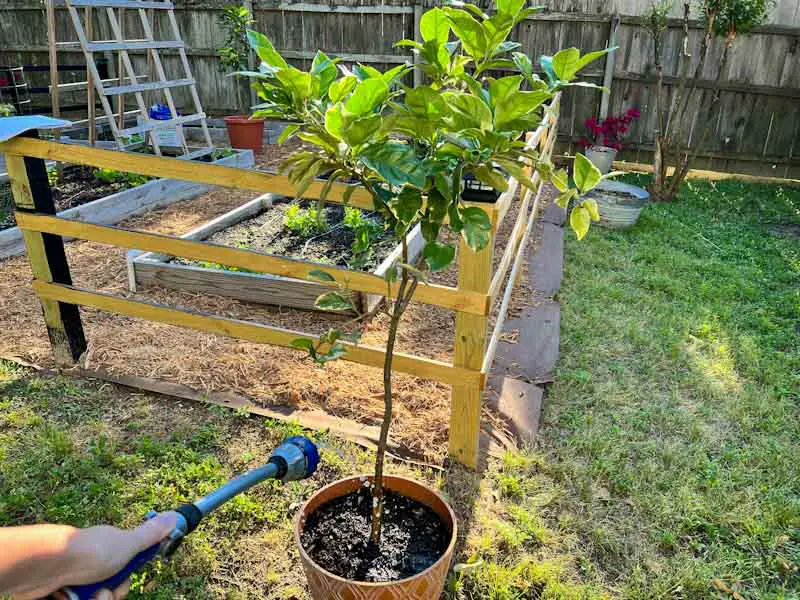
We may receive commissions from purchases made through links in this post, at no additional cost to you.
If you’re new to growing lemon trees, it can be tricky to know just how much to water them. Providing the right amount of water can make the difference between a lemon tree that is happily thriving and one that is struggling to survive.
One of the delights – and frustrations – of growing your own fruit is that no two plants have exactly the same needs. No two climates do, either. Just like with every other plant, lemon trees have different watering requirements depending on the weather, time of year, and whether it’s indoors or outdoors, potted or in-ground. So how do you figure out exactly when and how much to water a lemon tree?
Lemon trees should be watered deeply when the top 2-3 inches of soil are dry. To avoid overwatering, ensure the soil is well-drained, or if the tree is potted, that there are drainage holes. Adjust watering schedule according to the season, heat, humidity, size of the tree, and rainfall.
Determining your lemon tree watering habits will take some experimentation, but it starts with having an understanding of what can affect the the tree’s water needs. In this article, we’ll look at what factors affect watering, how and when to water both in-ground and potted lemon trees, and some helpful watering tips.
Figuring Out How Much to Water Lemon Trees
Lemon trees are native to Southeast Asia and thrive in the subtropical and tropical climates of the Mediterranean region, Central and South America, and the United States. But dwarf varieties can also be successfully grown in containers just about anywhere.
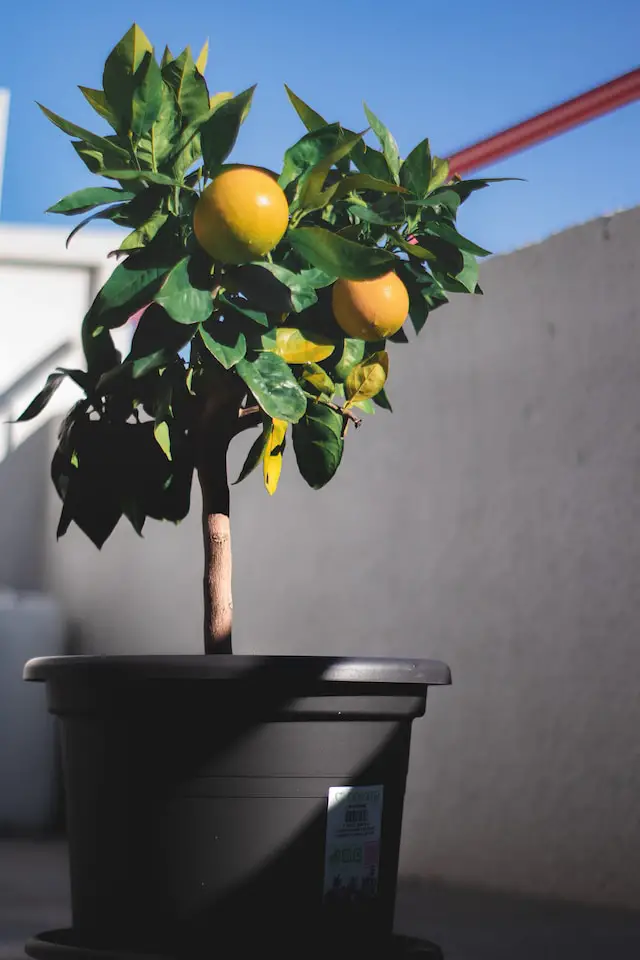
The climate and growing location are just two of the factors that can affect how much (and how often) to water lemon trees. Consider the following things when planning your lemon watering schedule.
Soil Drainage
All citrus trees need very well-draining soil, whether planted in the ground or in a pot. If you have soil with a lot of clay, expect to add compost, topsoil, or pine bark at planting to improve the drainage. Sandy soil that drains very fast will also benefit from added organic material to retain moisture.
Not sure if your garden soil is well-draining? Perform this test:
Dig a 1-foot by 1-foot hole and fill with water. Let the water drain, then fill again. Time how long it takes for the water in the hole to drain. If it takes far less than one hour to drain, then the spot may drain too quickly and have trouble retaining moisture. If it takes more than one hour to drain, then the spot may be too soggy.
Use the results of this test to determine what soil amendments may be necessary, or whether to choose a different planting location.
For potted lemon trees, use a lightweight soilless potting mix that includes aerating ingredients such as perlite and pine bark. Whatever soil you choose, be sure the pot has some drainage holes in the bottom to let extra water run out.
I wrote an article all about how to make (or buy) the best soil for container-grown citrus trees: The Best DIY Citrus Potting Mix Recipe (Plus 5 Brands to Try).
Pot Size
In general, the smaller the pot, the more frequent you may need to water. But the biggest consideration is how large is the pot in relation to the tree size. For example, a large tree in a smaller pot will be somewhat root-bound and will need frequent watering – and a larger pot as soon as possible.
Tree Age and Size
A mature lemon tree planted in the ground will have a far-reaching, extensive root system. It will be much more capable of seeking the water it needs from what is available deeper in the ground. A large, mature lemon tree should only need to be watered if there is a prolonged dry spell.
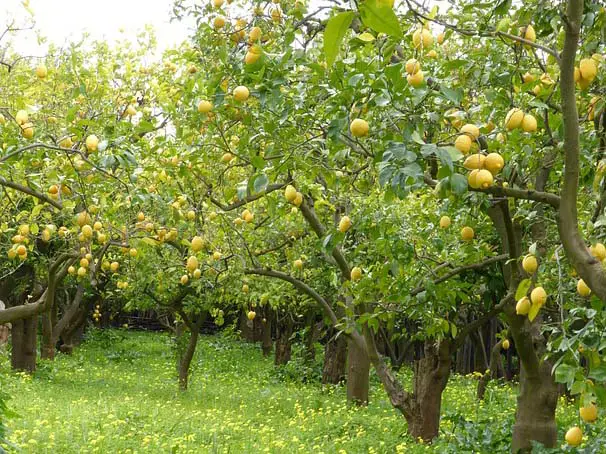
An older potted lemon tree will also have a more extensive root system, but far less room for roots to spread in the container. A larger potted tree may need to be watered more often, as there will be proportionately less soil in the container to retain moisture. Repot your lemon tree every few years to refresh the soil and trim the root ball, if necessary.
Season
No matter where they are planted, lemon trees need more water during flowering and fruiting than during winter semi-dormancy. Plan to increase watering during the active growing season, and pull back during the cooler months.
Sun and Temperature
Lemon trees need at least 6-8 hours of sunlight to fruit their best. This will mean more frequent watering as the temperatures heat up and the sun becomes more intense in the summer. In milder parts of the year, moisture will be slower to evaporate, so watering sessions can be spread out.
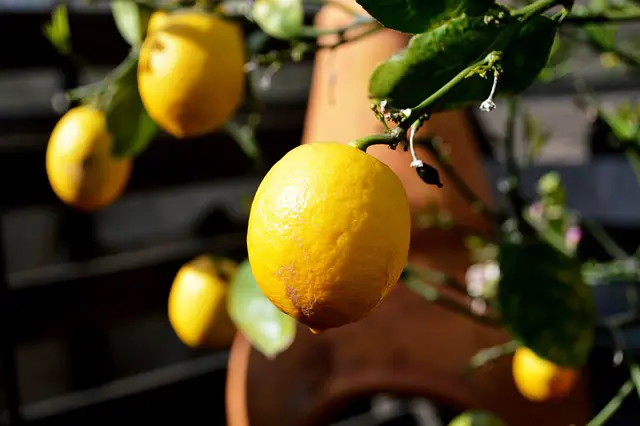
Rainfall
This is an obvious one, but worth stating anyway. During periods of frequent rainfall, you may not need to provide any supplemental water. Dry spells will call for some additional irrigation.
Wind and Humidity
Dry, windy weather will actually pull moisture from the leaves themselves, causing drought stress. Lemon trees prefer the humidity of subtropical and tropical climates. Strong winds and dry air, including that cause by indoor heating in the winter, may increase the watering needs of a lemon tree.
How to Water Potted Lemon Trees
1. Check the soil.
The easiest way to determine if your potted lemon tree needs water is by sticking your finger in the soil. If the soil up to your second knuckle (the top 2 to 3 inches) is dry, then it’s time to water. You can also use a soil moisture meter like this one to determine how dry your pot is.
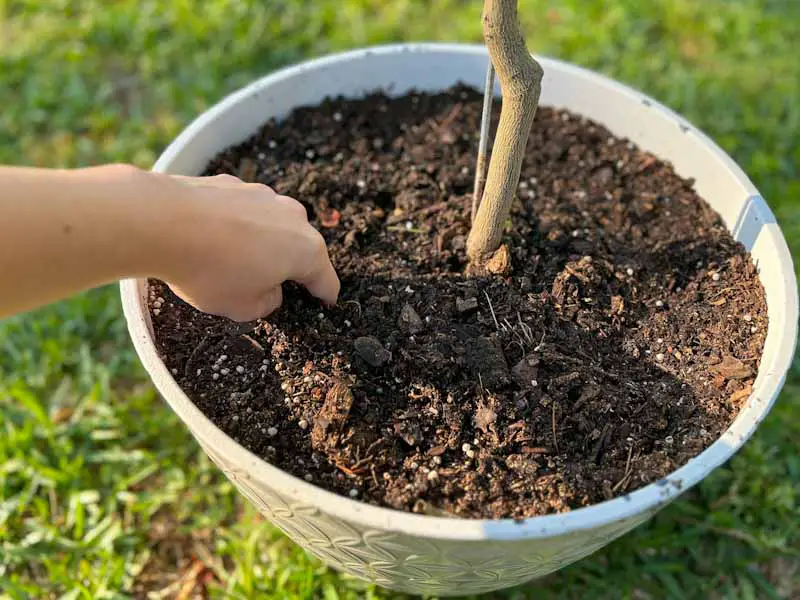
Potted fruit trees dry out much more quickly than those in the ground, particularly during the heat of summer. Avoid dark-colored pots if you live in a hot climate as these absorb more heat, which can dry out the roots.
Water lemon trees when the top 2-3 inches of soil is dry, or when the soil is dry up to the second knuckle of your finger.
2. Water from above or below.
Use a hose or watering can to water the lemon tree from above. Continue watering until you notice water coming out of the drainage holes at the base of the pot. Feel the soil to make sure it is evenly moist.
To water from below, use a large container or bin. Place the pot inside and fill the container with several inches of water. Wait 10-15 minutes; if the pot has absorbed all of the water but the top of the soil still seems dry, add some more water. After 30 minutes total, dump out any water remaining in the container and place the tree back in its spot.
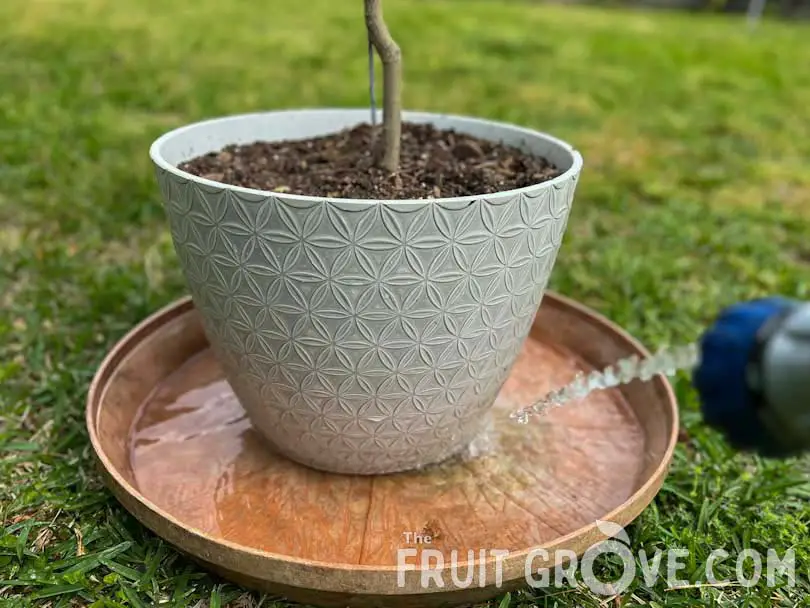
It may be best to use both methods to water your potted lemon trees. Over time, salts accumulate in the soil as a result of the irrigation water and fertilization used. Allowing plenty of water to drain through the pot will help flush out the harmful salt buildup. However, it will also flush out beneficial nutrients.
Watering from below does not remove nutrients from the pot, but it will also not flush out harmful salts. Alternate watering methods to get the best of both worlds.
3. Change the frequency of watering depending on the season.
I find that in the milder temperatures of spring and fall, I need to water my outdoor potted lemon trees every 3-4 days. As the weather heats up, increase watering to every 1-2 days. In the worst heat (90°F and above), I water every day in the morning, and sometimes also in the afternoon.
Increased watering also leads to an increased need for fertilization. Watering flushes nutrients out of the soil, so it’s important to fertilize potted lemon trees regularly to replace those nutrients.
Learn more: Fertilizing potted lemon trees: Everything You NEED to Know
In the winter, a lemon tree’s growth slows down significantly, which also lessens its need for water. Lemon trees need to be protected or brought indoors during the winter months in most climates. During this time, only water the tree enough to keep the roots from drying out, usually every 2-4 weeks.
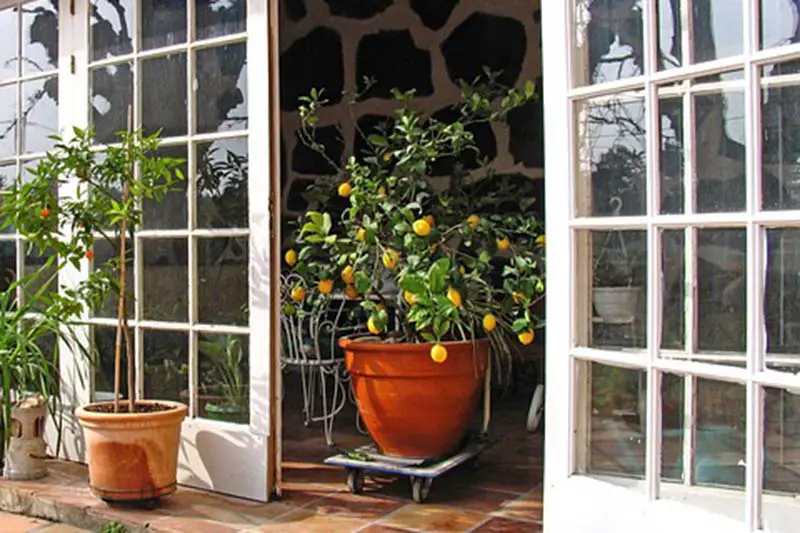
The tree never goes completely dormant, however. In fact, in some climates (zones 9-11), many lemon trees will continue to push out new growth even in winter. If you live in a hot climate where the tree continues to grow, water as usual throughout the year.
Indoors vs Outdoors
My aunt, a landscape designer and gardening guru, had a beautiful potted orange tree that lived out on her deck in the summer but spent half of the year happily next to a sunny window in her kitchen. Lemon trees, like other citrus, can be grown in containers indoors or out, but the location does change the watering requirements.
Indoor trees are not subject to wide temperature fluctuations and other weather. An indoor tree may only need to be watered once or twice per week during the flowering and fruiting season. As the tree’s growth slows in winter, water every 2 to 4 weeks to keep the soil from drying out completely.
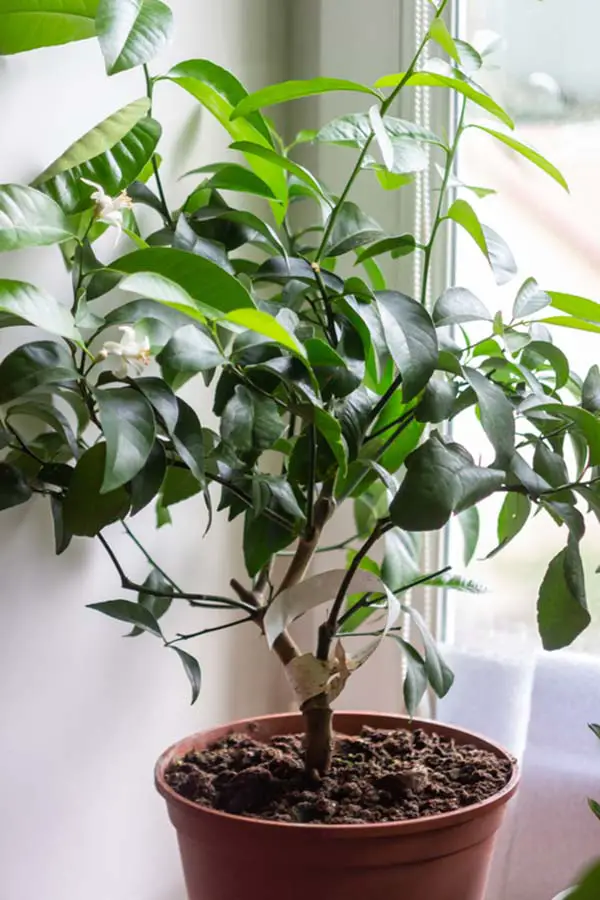
If you live in a very cold area and need to heat your house significantly, you may need to water a little more often in winter. Heat will pull the moisture out of the air, and therefore out of the lemon tree. Misting the leaves with some water every few days will help the tree retain some moisture indoors (find a great continuous-spray plant mister here).
Use room-temperature or tepid water when watering potted lemon trees, as cold water can shock the roots.
With outdoor potted trees, take the weather into account. Regular rainfall will decrease the need for additional irrigation. For few weeks during the spring stormy season, I rarely need to water my potted lemon trees. But once the weather heats up and dries out, it’s back to almost daily watering.
How often should you water potted lemon trees?
Water outdoor potted lemon trees about every 3-4 days when temperatures are mild, 2-3 days as the weather heats up, and daily in very hot weather.
Water indoor potted lemon trees about once or twice a week during the growing season. During winter semi-dormancy, water every 2-4 weeks to keep the roots from drying out.
Consider using a drip irrigation system with a timer for your outdoor potted trees. I use a B-hyve Smart Irrigation Timer from Orbit that attaches to a free app, so I can easily adjust the watering schedule depending on the weather and what my plants need. (I’m not an affiliate for them – I just really like their products!)
How to Water Lemon Trees in the Ground
For the most control in watering, and to avoid wetting the foliage, use a soaker hose or drip irrigation. I also use these watering bags for many of my young fruit trees. You fill the bags with water, then they have emitters that drip the water slowly for about 8 hours, giving the roots time to absorb the moisture.
You can also use a hose to water in-ground trees. Turn on the hose to a trickle, then place it near the dripline of the tree. Allow the hose to run slowly for 30 minutes to an hour. Move the hose around the tree once or twice to reach all of the roots.
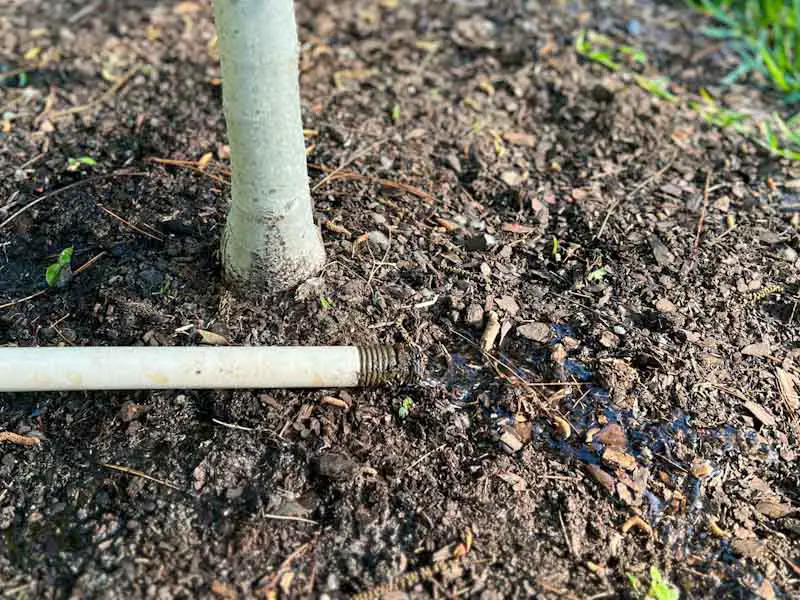
Newly planted lemon trees need frequent watering, no matter the climate. Until the roots have time to spread out and seek moisture in the ground, you have to keep the root ball well-watered. For the first couple of weeks, water your new tree every 2 days. Then increase to once or twice per week for the first few months.
A young tree can be watered by building a basin around the dripline of the tree. Mound up soil in a ring around the circumference just below the canopy, a couple of feet away from the trunk. Water will collect in the basin and soak into the root ball. If water tends to stand in the basin for several hours after rain, remove the soil mound.
For the first 2 years a tree is planted, water periodically throughout the growing season – particularly during dry spells (at least 5 days with no rain). The frequency will depend on how rainy it has been. It’s better to water deeply and less frequently. Shallow, frequent watering will encourage roots to grow toward the surface, causing them to dry out much more quickly.
Mature trees (3 or more years old) will generally only need additional watering during long dry spells. Overwatering may even cause more problems, such as fungal disease, root rot, or fruit drop.
Tips for Watering Lemon Trees
Signs of Over- or Underwatering
Overwatered lemon trees will have yellowed, droopy leaves that don’t perk up after watering, and may be slightly cupped. The leaves will then develop brown tips, wilt, and fall off the tree. Too much water can cause root rot and will encourage bacteria and fungal diseases. Overwatering is a common cause of lemon tree death.
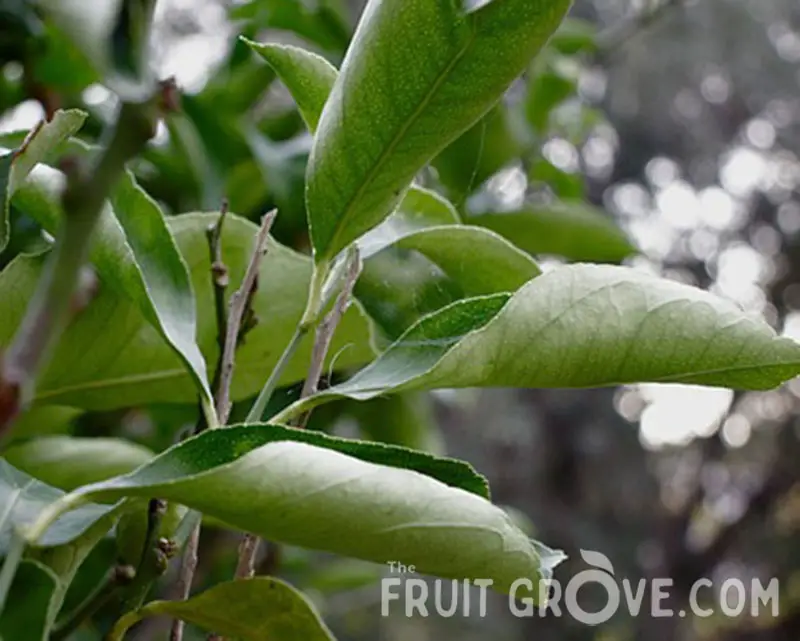
A lemon tree that receives too little water will first show leaves that curl in longways, like a cigar, while still remaining green. Young leaves, in particular, will appear droopy. Eventually, these leaves will become dry, brown, and fall off. Flowers and fruit may drop early as well.
Learn more: Is Your Citrus Tree Overwatered or Underwatered?
Mulching
An easy way to regulate the moisture level of your lemon tree is with mulch. Lay a 3- to 4-inch deep layer of organic mulch around an in-ground tree, leaving a few inches of space around the trunk to avoid rot. I also mulch my container-grown lemon trees with a couple of inches of compost or pine bark. I find this makes a big difference in how often I have to water them.
Fertilizing
Watering and fertilizing go hand-in-hand, especially with potted trees. The more you water, the more frequently you need to replace the available nutrients in the pot. Learn about when, how, and what to use to feed container lemon trees here: Fertilizing Potted Lemon Trees: Everything You NEED to Know.

